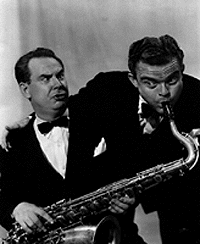The Big Rock Candy Mountain and Other Comic Utopias

Photo postcard from 1912
I wish somebody would tell me what Diddie Wa Diddie means. (Blind Blake, 1929)
What is Doo Wah Ditty? ThatÕs all I ask! (Jack Benny, 1948)

Photo postcard from 1912
I wish somebody would tell me what Diddie Wa Diddie means. (Blind Blake, 1929)
What is Doo Wah Ditty? ThatÕs all I ask! (Jack Benny, 1948)
Diddie Wah Diddie, Doo Wa Ditty, the Big Rock Candy Mountain, the Land of Cockaigne, Lubberland, Schlaraffenland, and Nowhere share a history that follows a straight, crooked course extending further back in time and covering far more territory than might be thought possible of what today remain most familiar as subjects of simple children's songs and obscure folk tales. These remarkable places lie within the broader borders of equally remarkable lands that exist far beyond here or anywhere and maybe not even somewhere. Although Nowhere can be found in the imaginative landscape of every land's folklore, NOWHERE IN AMERICA: THE BIG ROCK CANDY MOUNTAIN AND OTHER COMIC UTOPIAS (University of Illinois Press, l990) proposes to identify and describe its presence in the imaginative landscape of America. From its earliest documented appearances in the Greek Attic comedies of Teleclides, images and confabulations of a world turned upside down where rivers flow with milk, wine, and whiskey, where hens lay hard-boiled eggs, and clouds rain apple pies flow into the marvelous nooks and crannies of American popular culture. NOWHERE IN AMERICA chronicles the appearance of these marvels in Dogpatch (with L'Abner and the Shmoo); in the blues of Blind Blake, Mississippi Fred McDowell, and Sleepy John Estes; in the repertoire of Bo Diddley, Earl MacDonald's Original Louisville Jug Band, Bob Wills and the Texas Playboys, and Haywire Mac McClintock; in the cartoons of Windsor McCay, Walt Kelly, Charles Addams, and Carl Barks; and in the film comedies of Laurel and Hardy, Charlie Chaplin, Terry Gilliam, Pee Wee Herman, and Charlie Bowers.
In MAD LOVE (1937), taking note of the cultural and poetic persistence
of such extravagant and topsy-turvey imagery ("tree for bread, tree for
butter"), Andre Breton observes: "One myth among all others, clear and
without harshness, is developed starting with this tree: that of the inexhaustible
natural generosity able to see the most diverse human needs . . . How to
resist the charm of a garden like this one, where all the trees of a providential
type have gathered? . . . The bread tree, the butter tree have called to
them the salt tree: a whole frugal lunch is being improvised. How hungry
we are!" That hunger, for plentitude and freedom, is the subject of this
book.

In the early l940s saxophonist/vocalist Red Ingle recorded and toured with Spike Jones and the City Slickers. The discovery of an old 78 titled "Nowhere" by Red Ingle and his Natural Seven, a 1947 parody combining "That's What I Like About the South" with "You Came Along (from Out of Nowhere)." inspired the research that produced this book.
| more about Hal Rammel |